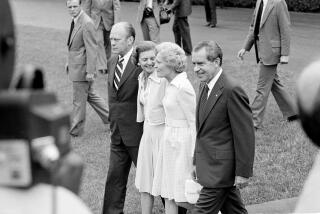A Museum That Suits Ford to a T
DEARBORN, Mich. â Henry Ford is best remembered for revolutionizing the automobile industry, but his passion for collecting Americana also is an important part of his legacy.
Collecting was an obsession for Ford. Of particular interest to him were items that showed âhow far and how fast weâve comeâ from Colonial times to the 20th Century.
For 60 years his collection of Americana--unparalleled in size, range and diversity--has been housed on 254 acres at Greenfield Village and in the adjacent vast Henry Ford Museum in this Detroit suburb.
The 14-acre museum is filled with thousands of items ranging from utensils, dinnerware, appliances, jewelry, furniture, tools, bicycles, agricultural implements, carriages, automobiles, streetcars and trains to mammoth pieces of machinery from 18th- and 19th-Century factories and foundries.
The history of domestic life is detailed, from open-hearth cooking to the electric range. Also assembled are the simple inventions of the last 300 years, such as eggbeaters, hand-cranked washing machines, toasters, waffle irons, carpet sweepers, early radios and TVs.
Since November, 1987, the $6-million Automobile in American Life exhibit has been featured in a 60,000-square-foot area of the museum devoted to the evolution of the automobile, its industry and effect on 20th-Century America.
Graphics, films and 100 historic cars on spiraling ramps depict the development of motorized vehicles, assembly lines and roadside businesses that serve motorists.
Included is the only 1896 Duryea motor wagon known to exist. Charles and Frank Duryea launched the American automobile industry 93 years ago in Springfield, Mass., by producing 13 identical gasoline-powered vehicles. Next to the Duryea is a 1865 Roper steam carriage, one of the earliest self-propelled road vehicles. Nearby is the Ford Trimotor airplane (the Tin Goose), which Adm. Richard E. Byrd piloted in the first flight over the South Pole.
The invention of the car also brought about numerous cultural changes, also depicted at the museum. Among the displays are Clovis Lamyâs 1946 Marlboro, Mass., diner; a 1930s Howard Johnson Simple Simon and the Pieman sign; a 1940 Texaco service station; a 1941 Lore-Mac $3 a night tourist cabin from Irish Hills, Mich., and an early Holiday Inn neon sign.
A âStreamlining Americaâ exhibit is filled with Art Deco items, including a fully furnished 1930s home and hundreds of streamlined appliances and radios from the â20s and â30s.
Across from the museum is Greenfield Village filled with historic homes and workshops, including the home in which Orville and Wilbur Wright were born and the small Dayton, Ohio, bicycle shop where they built the worldâs first flying machine. Also here is the Logan County, Ill., courthouse where Abraham Lincoln practiced law. Inside is the red Victorian rocking chair that Lincoln was seated in when assassinated April 14, 1865.
Among the other exhibits: Thomas Edisonâs two-story, clapboard invention factory, originally located in Menlo Park, N.J.; Sarah Jordanâs boarding house, the first dwelling to be fully illuminated by incandescent light bulbs; a steam-powered sawmill; a 19th-Century foundry, tintype studio, tinsmith and cooper shops, railroad roundhouse and carriage repair shop.
To honor his close friend and hero Thomas Edison, Ford called his museum and village the Edison Institute. The complex was dedicated Oct. 21, 1929, the 50th anniversary of Edisonâs invention of the incandescent lamp. Edison was on hand for the opening. Several years after Fordâs death the name was changed to the Henry Ford Museum.
Initially, the museum and Greenfield Village were operated as part of a private school where, Ford said, âstudents would be able to go far beyond textbooks in their studies.â
Monica Starrett, 57, who works in the museumâs interpretation department, studied at Edison Institute from kindergarten through high school. Her father was Alfred Lepine, secretary to Fordâs son, Edsel.
âSome of the students, like myself, were children of Ford employees and others came from families whose parents worked elsewhere,â she said. âIt was a popular school with a long waiting list of students hoping to attend. The enrollment was always small, never more than 200.â
Classes were held in nine historic Greenfield Village buildings, including the 19th-Century red Scotch Settlement School that Henry Ford attended as a youngster and the log cabin McGuffey School, birthplace of the first school textbook.
Ford visited classrooms on a regular basis, Starrett said. âThere was always a lot of excitement when he came. We used the usual textbooks for classes, but whatever we studied there was always something in the museum or in the village that would relate to the subject matter.
âIt was a wonderful hands-on way of learning. If we were studying about Colonial America, we would walk down the road to the original Colonial homes in the village. If we were studying inventors, we would spend time in Thomas Edisonâs Menlo Park Laboratory.â
During the â30s and â40s, when Starrett attended the school, the Henry Ford Museum and Greenfield Village were not open to the public. âI have no recollection of a lot of visitors here when I was in school,â she said. The high school closed in 1952; the elementary school in 1969.
Fordâs legacy of Americana is an independent nonprofit educational institution and is not part of nor is it supported by the Ford Motor Co. or the Ford Foundation. It operates on a yearly budget of $19 million, one-third from entrance fees, one-third from sales of food and merchandise and one-third from endowments. Last year 1.3 million people visited the Henry Ford Museum and Greenfield Village.
Forty years after his death, collecting still goes on in the Henry Ford tradition. The Harvey Firestone farm, for example, including the tire manâs birthplace and several farm buildings, were brought here from Ohio in 1981.
More to Read
The biggest entertainment stories
Get our big stories about Hollywood, film, television, music, arts, culture and more right in your inbox as soon as they publish.
You may occasionally receive promotional content from the Los Angeles Times.









